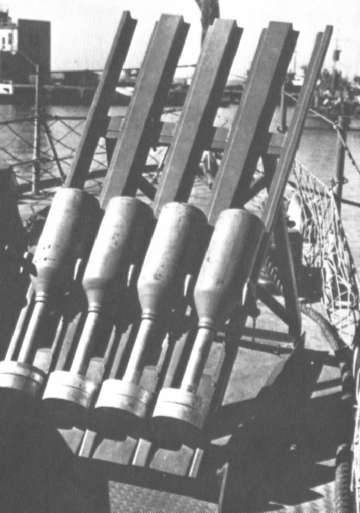

However,
the benefits of Hedgehog could be of use in the large number of small subhunters,
the PCs, which rarely even sighted a submarine but which made for good
coastal escorts nevertheless. The new weapon, ordered developed early in
1942, was to fit on the small ships and yet be able to deliver an effective
pattern of charges, 70ft wide. Those were originally intended to be slightly
larger than the original Hedgehog round, but problems with the development
of that new charge caused it to be abandoned in favor of the original Hedgehog
round. A rocket (in this case meaning a slow-burning propellant) was attached
to the lower body to make it fireable without the recoil inherent in Hedgehog.
Mousetrap suffered from
a far smaller pattern, lack of stabilization and range adjustment, and
was not the equal of Hedgehog. It was, nevertheless, installed in large
numbers aboard small craft and even on twelve fleet destroyers (because
it could be mounted alongside the superstructure). These weapons were Mk
22 projectors, paired to equal a Hedgehog salvo, but was unsuccessful,
probably causing the loss of the destroyer Turner in early 1944.
Mk 20 was a four-rail projector,
while Mk 22 added two rails on each side for a total of eight. Mk 22 was
standard later in the war; Mk 20 being adapted to fit the additional rails.
|
|
Usual range: 280 meters / 300 yards
Mount Weight: ?????lbs / ????? kg Sinking Speed: 7.6 m/s / 25 f/s Rate of fire: 1 per 3 minutes Charge: 65lbs / 30kg |